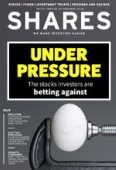Archived article
Please note that tax, investment, pension and ISA rules can change and the information and any views contained in this article may now be inaccurate.
How Fevertree qualifies as the one of the best growth companies

This is part TWO of three articles looking at how to find and analyse growth stocks. In this second article we take a closer look at an individual UK-listed company and how to identify and define its growth. In part three we will turn to valuation.
This is the second part of our series on how to find and analyse growth stocks.
As a reminder, we are attempting to find companies which can grow their earnings per share by at least 10% a year and maintain high returns on equity (ROE). This is fundamental to profit and shareholder returns.
ROE is net profit divided by book value and a ratio above 15% is a good indicator of a quality business which possesses durable economic advantages.
Companies like this benefit from compounding, which refers to the stunning effects of multiplying growth on top of prior growth.
SCREENING FOR GROWTH
Shares has utilised Stockopedia software to create a screen to isolate possible growth share candidates.
In part one we discussed ways to find growth companies and we use one of the approaches here.
Companies with a demonstrable track record of growth are more likely to continue to grow in the future especially when they possess economic advantages. This usually shows up in quality metrics like high returns on equity.
Economic advantages can include brand strength, intellectual property rights, scale, high barriers to entry, network effects, and high switching costs.
Research conducted by Guinness Global Investors has shown that companies which are able to consistently achieve higher than average returns on capital over a decade have an 80% chance of continuing to do so over the following four years.
The Shares screen also applies a filter to identify high expected shareholder returns. This is based on sustainable growth as described by Mary Buffett in the book Buffettology (See Calculating expected shareholder returns overleaf).
The screen a requires a company to have a minimum 20% expected shareholder return to qualify.
The screen reduces the UK share universe down to around 30 candidates.
From this list Shares has chosen premium mixer drinks disrupter Fevertree (FEVR) as a candidate to explore.
Like most successful companies Fevertree has an interesting backstory. Co-founder Charles Rolls quit his engineering job in 1997 to buy struggling gin brand Plymouth for £500,000.
Despite having no relevant experience Rolls managed to turn the business around as the popularity of gin made a renaissance. Four years later he sold Plymouth for £28 million, making 56 times the purchase price.
One thing he took away from the experience (apart from a lot of cash) was that it didn’t matter what the gin tasted like if the tonic mixers weren’t up to scratch.
Rolls set about testing tonics and when entrepreneur Tim Warrilow approached him about starting a new gin company Rolls suggested that, instead, they start a new tonic water company and Fevertree was born.
At the time the mixer market was considered a commodity by incumbents like Schweppes with very little innovation.
Schweppes used to be part of UK confectioner Cadbury Schweppes but today beverage giant Coca-Cola (KO:NYSE) owns the brand in several territories including 21 European countries.
Schweppes International, a subsidiary of Suntory, owns the brand in a further 22 countries.
Fevertree is the leading premium mixer brand in the UK with around 40% of the market. In 2021 it overtook Schweppes in the US for the first time, nabbing a 26% share. Fevertree is the leading ginger brand in the US.
The company does not use artificial sweeteners, preservatives or flavours in the products, making them stand out in the marketplace.
The products are differentiated by their premium ingredients with an emphasis on provenance.
The quinine comes from the Democratic Rpublic of Congo and the ginger root is from the Ivory Coast, Nigeria, and India.
In 2021 Fevertree shipped 546 million bottles and cans in over 70 countries.
Calculating expected shareholder returns
Sustainable growth in the context of this analysis is the amount of cash available to reinvest in the business based on return on equity.
For example, if Company X’s book value is £100 and ROE is 15%, there would be £15 available to reinvest in growth which means the company can theoretically grow at 15% if no dividends are paid.
We can use the ROE and retention ratio (100% in the above example) to estimate future book value. Taking a 10-year average smooths the data.
Continuing with the same example, let’s say the average worked out to be a 15% ROE and all profits were retained. We further assume that pattern continued over the next decade.
In year two book value will start at £115 (£100 + £15) but the higher base means profit that year would increase to £17.25 and book value would grow to £132.25 (£15 profit in year one plus £17.25 in year two).
This continues and in year 10 book value is a whopping £404.55 and earnings will be £60.68. (15% of £404.55)
How much will investors pay for those earnings? Again, we can apply a 10-year average. Let’s say the average is 20 times.
We can calculate a theoretical market price by multiplying year 10 earnings of £60.68 by a PE of 20 times which equals £1,213.60.
Assuming investors are willing to pay 20 times for the current £15 of earnings this implies a price of £300 (£15 x 20).
The future price is 304% higher which is equivalent to a compound annual growth rate of 15% a year. This is the expected shareholder return.
IS GROWTH ATTRACTIVE AND SUSTAINABLE?
It is important to seek out the growth drivers to determine if they are sufficiently sustainable to drive shareholder value.
Between 2012 and 2019, the premium global mixer category grew at almost five times the rate of the total mixer category according to Fevertree.
Even more impressively, Fevertree has grown at twice the rate of the wider premium category.
According to consultancy Statista the global soft drinks market is worth nearly a trillion dollars and is forecast to grow at around 7% a year on average over the next six years.
Fevertree has grown sales from £34.7 million when the company floated in 2014 to an estimated £364 million in 2022. That represents a compound annual growth rate of 34% a year. Earnings per share have grown at 50% a year.
Looking forward sustainable trends such as premiumisation, wellness and health (think lower alcohol drinks and mocktails) and increased interest in craft should act as growth tailwinds for the company.
While there have been worries about saturation in the UK market, Fevertree’s continued expansion overseas should keep the growth rate rattling along in double digits for the next few years.
As we discussed in part one of this series, sales growth is only half the story because it is profit and cash flow growth which drive the share price.
In the final part we will look at Fevertree’s profitability, the very competitive landscape in which it operates and the valuation of the business.
Important information:
These articles are provided by Shares magazine which is published by AJ Bell Media, a part of AJ Bell. Shares is not written by AJ Bell.
Shares is provided for your general information and use and is not a personal recommendation to invest. It is not intended to be relied upon by you in making or not making any investment decisions. The investments referred to in these articles will not be suitable for all investors. If in doubt please seek appropriate independent financial advice.
Investors acting on the information in these articles do so at their own risk and AJ Bell Media and its staff do not accept liability for losses suffered by investors as a result of their investment decisions.
Issue contents
Education
Feature
Great Ideas
Investment Trusts
News
- Supermarket sales slide extends to over a year as shoppers trade down
- Trustpilot pulls forward breakeven target at its big investor day
- Henderson manager hits the sell button on Shell
- Why Primark's plan to trial new click and collect service could be smart
- How rising interest rates are increasing the risk of recession

 magazine
magazine








